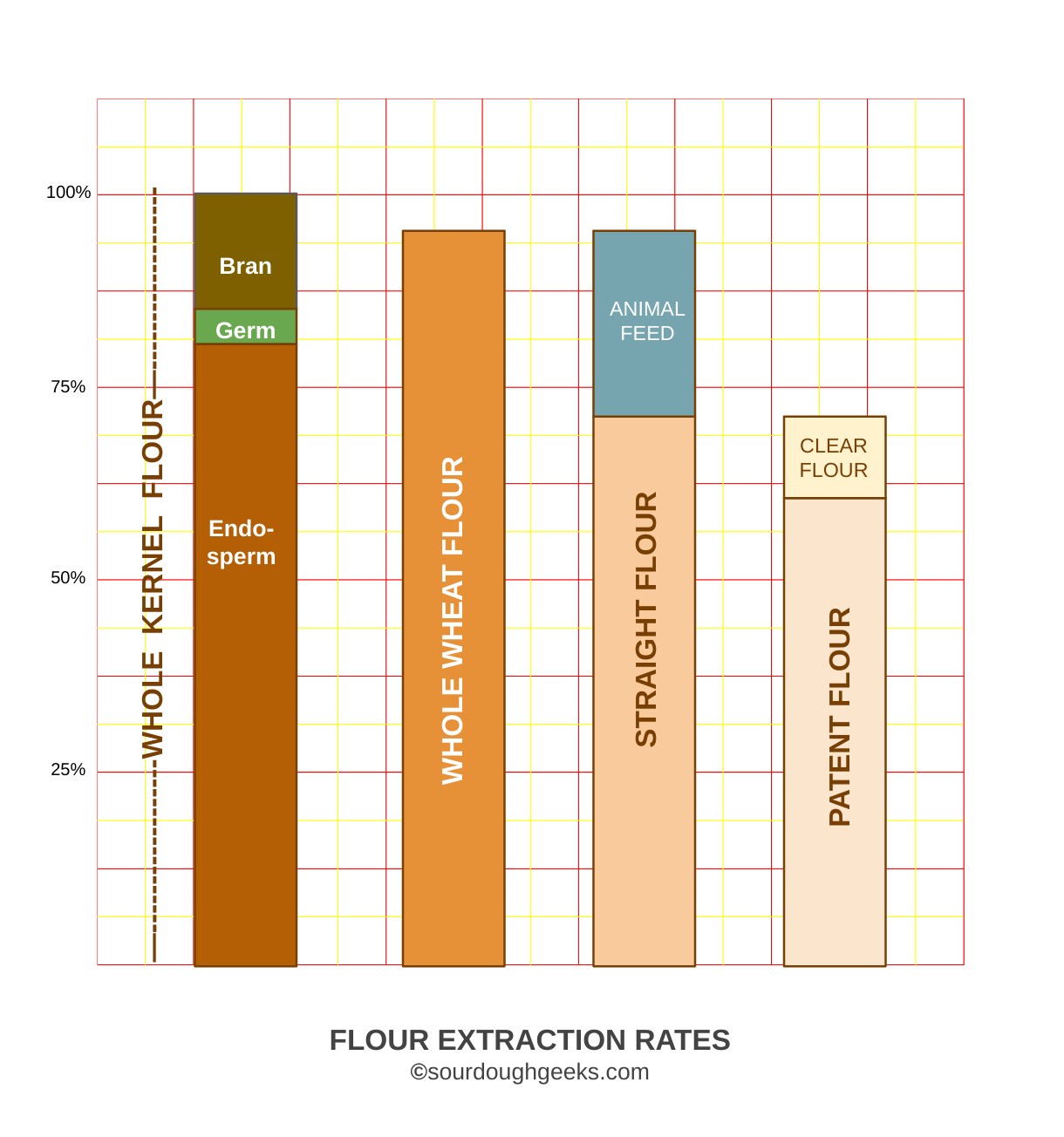
Understanding Flour Extraction Rate: A Comprehensive Guide
When exploring various flour options, you may have encountered the term 'extraction rate.' So, what does extraction rate mean, and what can it tell us about a particular flour? It turns out that the meaning can vary slightly depending on the type of flour. Confused already? Let’s demystify it a bit!
Flour Classifications
Before diving into extraction rates, let’s take a step back and examine the broader classifications of flour, focusing specifically on wheat flour. Wheat flour is broadly divided into two main categories: refined and unrefined. Unrefined flour includes all parts of the wheat berry (germ, bran, and endosperm), whereas refined flour has some portion sifted off. There’s further nuance depending on whether the flour is stone milled or roller milled, which partly explains why extraction rate can mean slightly different things.
Stone Milled vs. Roller Milled Flour
Stone-milled flour is generally more nutritious and flavorful than most store-bought flour because it undergoes less processing. In contrast, roller-milled flour involves an additional refining step. Even with whole wheat roller-milled flour, the grains have been highly processed, with parts being separated out and later reconstituted. The only requirement for a roller-milled “whole wheat” flour is that the parts be reassembled in approximately the same ratios as they were in the intact kernels.
What is Extraction Rate?
In basic terms, the extraction rate is the amount of whole grain that remains in flour after sifting. Whole kernel flour has an extraction rate of 100%, and the closer the extraction rate is to 100%, the higher the amount of whole grain in the flour.
For example, a flour with an 80% extraction rate means that 20% of the kernel weight has been sifted off, mostly in the form of the bran fraction. Removing some of the bran generally gives a lighter texture and more volume to the resulting bread since bran interrupts gluten formation in dough and is denser than both the germ and endosperm.
Extraction Rates in Roller Milled Flour
Most flour available in supermarkets is roller milled and has been refined twice to achieve a whiter appearance. Initially, it is separated at an extraction rate of 72%, removing almost all the bran and germ. This results in a flour known as ‘straight’ flour. Due to milling inefficiency, a small portion of bran and germ remains in straight flour. This flour is then refined again, with 85% of that flour being eventually sold as ‘patent’ flour. Therefore, refined white flour has a true extraction rate of approximately 60%. These are the all-purpose (AP) and bread flours widely available in supermarkets, with the fiber, essential minerals, and fatty acids removed. Because all the bran and germ have been stripped out, these flours are essentially shelf-stable and can be treated as commodity items.

Expressing Extraction Rates
You may have seen flour described using terms like Type 85. Extraction rates can be expressed in different ways, or they may just be listed outright as extraction rates. When flour has less than 100% extraction, you might also see terms like sifted or bolted, indicating that some portion of the grain has been removed.
Sometimes, the number listed on an extraction rate relates to the ash content of the flour. Ash content is the amount of bran and germ remaining in the flour, expressed as the percentage of minerals present in those parts of the kernel. So, a listed extraction rate of T65 can mean the mineral content of that flour is 0.65% (or thereabouts).
How to Interpret Extraction Rates
- If the number listed is greater than 100, this means it is an expression of ash (mineral) content.
- If the flour is stone-milled, more often than not extraction rate will be the percentage of the whole kernel that is present in the flour. If it is roller-milled, the opposite is normally true, with extraction rate indicating ash content.
- Some mills (such as Janie's Mill) actually list it both ways. So you will see an extraction rate as a percentage of the whole kernel, with ash content and other information such as total protein, falling number and moisture level also listed.
Supermarket flour rarely lists extraction rates. However, millers like Janie’s Mill always specify the extraction rate on their flours, giving you insight into how the flour will perform in baking. Their sifted flours are fresher and less refined, packed with more essential nutrients than anything available in the supermarket.
Use code GEEKS40 for free shipping on orders $40+ or GEEKS10 for 10% off any order at www.janiesmill.com/
Why Choose Higher Extraction Flour?
Even the most refined flour from Janie’s Mill contains more of the whole grain than roller-milled flour from the supermarket. More bran, more germ, more fiber, more vitamins, more trace minerals, and more flavor. Due to the germ's essential fatty acids, treat stone-milled, high extraction flours as perishable. Store them at refrigeration temperature to preserve both taste and nutrients.
By understanding flour extraction rates, you can make more informed choices about the flours you use, ensuring better nutritional value and baking performance. Whether you’re a home baker or a professional, knowing your flour can make all the difference in your culinary creations.
🤓 LEVEL UP YOUR LOAVES! Become an Official Geek for just $5/month (or $50/year) and unlock the good stuff: free courses, video tutorials, live bake-alongs, secret recipes, tasty discounts, our private geek HQ, and BREAD TALK — our twice-monthly, real-time video hangouts.
👉 Not quite ready to go full geek? No worries — you can still snag our Mastering Sourdough Starter course for just $19.99 here.

